Toshiba XD-E500KU, XD-E500KC User Manual
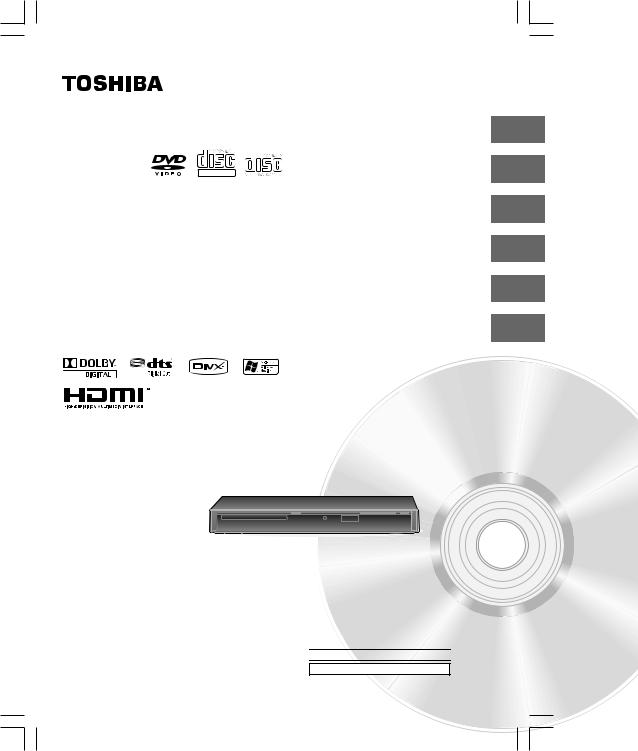
|
Introduction |
2 |
|
|
|
||
|
Connections |
11 |
|
DIGITAL VIDEO |
|
|
|
DVD PLAYER |
Basic playback |
16 |
|
XD-E500KU |
Advanced playback |
19 |
|
XD-E500KC |
|||
Function setup |
29 |
||
|
|||
|
Others |
35 |
OWNER’S MANUAL
24F
480p 1080p
720p 1080i
Owner’s Record
The model number and serial number are on the back of your DVD Player. Record these numbers in the spaces below. Refer to these numbers whenever you communicate with your Toshiba dealer about this DVD Player.
Model number: 

Serial number:
© 2008 Toshiba Corporation
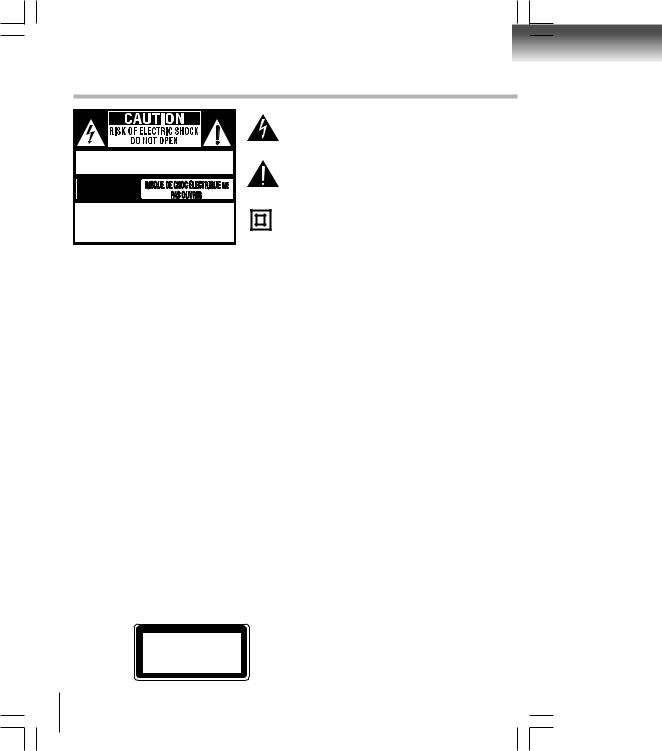
Introduction
SAFETY PRECAUTIONS
CAUTION: VISIBLE LASER RADIATION WHEN OPEN. DO NOT STARE INTO BEAM.
AVIS
WARNING: TO REDUCE THE RISK OF ELECTRIC SHOCK, DO NOT REMOVE COVER (OR BACK). NO USER-SERVICEABLE PARTS INSIDE. REFER SERVICING TO QUALIFIED SERVICE PERSONNEL.
The lightning flash with an arrowhead symbol, within the equilateral triangle, is intended to alert the user to the presence of uninsulated "dangerous voltage" within the product's enclosure that may be of sufficient magnitude to constitute a risk of electric shock to persons.
The exclamation point within the equilateral triangle is intended to alert the user to the presence of important operating and maintenance (servicing) instructions in this owner’s manual.
The symbol for Class 
 (Double lnsulation)
(Double lnsulation)
WARNING: |
TO REDUCE THE RISK OF FIRE OR ELECTRIC SHOCK, DO NOT EXPOSE THIS APPLIANCE TO RAIN |
|
OR MOISTURE. DANGEROUS HIGH VOLTAGES ARE PRESENT INSIDE THE ENCLOSURE. DO NOT |
|
OPEN THE CABINET. REFER SERVICING TO QUALIFIED PERSONNEL ONLY. |
CAUTION: |
TO PREVENT ELECTRIC SHOCK, MATCHWIDE BLADE OF PLUGTO WIDE SLOT OF AC POWER OUTLET, |
|
THEN FULLY INSERT. |
WARNING: |
The apparatus shall not be exposed to dripping or splashing and that no objects filled with liquid, such as |
|
vases, shall be placed on the apparatus. |
CAUTION: |
This Digital Video Disc Player employs a Laser System. |
|
To ensure proper use of this product, please read this owner’s manual carefully and retain for future |
|
reference. Should the unit require maintenance, contact an authorized service location. |
|
Use of controls or adjustments or performance of procedures other than those specified herein may result |
|
in hazardous radiation exposure. |
|
To prevent direct exposure to laser beam, do not try to open the enclosure. |
|
Visible and invisible laser radiation when open and interlocks defeated. |
|
DO NOT STARE INTO BEAM. |
FCC NOTICE: |
This equipment has been tested and found to comply with the limits for a Class B digital device, pursuant |
|
to part 15 of the FCC Rules. These limits are designed to provide reasonable protection against harmful |
|
interference in a residential installation. This equipment generates, uses, and can radiate radio frequency |
|
energy and, if not installed and used in accordance with the instructions, may cause harmful interference |
|
to radio communications. However, there is no guarantee that interference will not occur in a particular |
|
installation. If this equipment does cause harmful interference to radio or television reception, which can |
|
be determined by turning the equipment off and on, the user is encouraged to try to correct the interference |
|
by one or more of the following measures: |
|
- Reorient or relocate the receiving antenna. |
|
- Increase the separation between the equipment and receiver. |
|
- Connect the equipment into an outlet on a circuit different from that to which the receiver is connected. |
|
- Consult the dealer or an experienced radio/TV technician for help. |
WARNING: |
Changes or modifications to this unit not expressly approved by Toshiba, or parties authorized by Toshiba, |
|
could void the user authority to operate the equipment. |
Warnings: • The main plug is used as disconnect device and it should remain readily operable during intended used. In order to disconnect the apparatus from the mains completely, the main plug should be disconnected from the mains socket outlet completely.
•Minimum 10 cm (4 inches) distances around the apparatus for sufficient ventilations.
•The ventilation should not be impeded by covering the ventilation openings with items such as newspaper, table-cloths, curtains, etc.
•No naked flame sources such as lighted candles should be placed on the apparatus.
•The use of apparatus in moderate climates.
CLASS 1
LASER PRODUCT
2
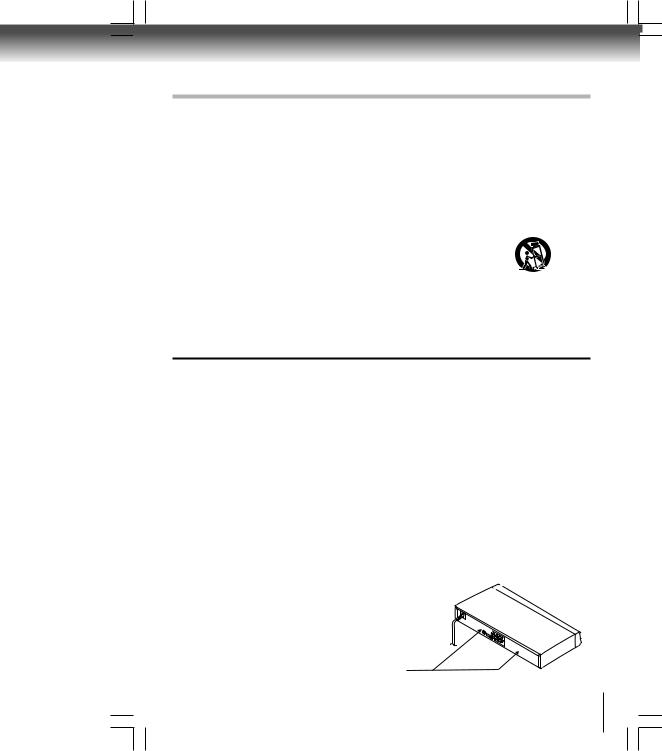
IMPORTANT SAFETY INSTRUCTIONS
1. |
Read these instructions. |
|
|
2. |
Keep these instructions. |
|
|
3. |
Heed all warnings. |
|
|
4. |
Follow all instructions. |
|
|
|
|
||
5. |
Do not use this apparatus near water. |
|
Introduction |
6. |
Clean only with a dry cloth. |
|
|
|
|
||
7. |
Do not block any of the ventilation openings. Install in accordance with the manufacturer's instructions. |
|
|
8. |
Do not install near any heat sources such as radiators, heat registers, stoves, or other apparatus (including amplifiers) |
|
|
|
that produce heat. |
|
|
9. |
Do not defeat the safety purpose of the polarized or grounding-type plug. A polarized plug has two blades with one wider |
|
|
|
than the other. A grounding type plug has two blades and a third grounding prong. The wide blade or the third prong is |
|
|
|
provided for your safety. If the provided plug does not fit into your outlet, consult an electrician for replacement of the |
|
|
|
obsolete outlet. |
|
|
10. |
Protect the power cord from being walked on or pinched particularly at plugs, convenience receptacles, and the point |
|
|
|
where they exit from the apparatus. |
|
|
11. |
Only use attachments/accessories specified by the manufacturer. |
|
|
12. Use only with the cart, stand, tripod, bracket, or table specified by the manufacturer, or |
|
|
|
|
sold with the apparatus. When a cart is used, use caution when moving the cart/apparatus |
|
|
|
combination to avoid injury from tip-over. |
Portable Cart Warning |
|
13. |
Unplug this apparatus during lightning storms or when unused for long periods of time. |
|
|
|
|
||
14. |
Refer all servicing to qualified service personnel. Servicing is required when the apparatus has been damaged in any |
|
|
|
way, such as the power-supply cord or plug is damaged, liquid has been spilled or objects have fallen into the apparatus, |
|
|
|
the apparatus has been exposed to rain or moisture, does not operate normally, or has been dropped. |
|
|
ADDITIONAL SAFETY INSTRUCTIONS
15.Do not overload wall outlets; extension cords, or integral convenience receptacles as this can result in a risk of fire or electric shock.
16.Never expose the apparatus to dripping or splashing or place items such as vases, aquariums, any other item filled with liquid, or candles on top of the unit.
17.Keep your fingers well clear of the disc tray as it is closing. Neglecting to do so may cause serious personal injury.
18.Do not place anything on top of this unit.
19.Do not place the apparatus on amplifiers or equipment that may produce heat.
20.Never block or cover the slots or openings in the unit. Never place the unit:
•on a bed, sofa, rug or similar surface;
•too close to drapes, curtains, or walls; or
•in a confined space such as a bookcase, built-in cabinet, or any other place with poor ventilation.
The slots and openings are provided to protect the unit from overheating and to help maintain reliable operation.
21.Do not use a cracked, deformed, or repaired disc. These discs are easily broken and may cause serious personal injury and apparatus malfunction.
22.If the apparatus should emit smoke or an unusual odor, immediately disconnect the power cord from the wall outlet. Wait until the smoke or smell stops, then ask your dealer for a check and repair. Neglecting to do so may cause fire.
23.During thunderstorms, do not touch the connecting cables or the apparatus.
24.Warning: To prevent spread of fire, keep candles or other open flames away from this product at all times.
Location of the required label
The rating plate and the safety caution are on the rear of the unit.
3
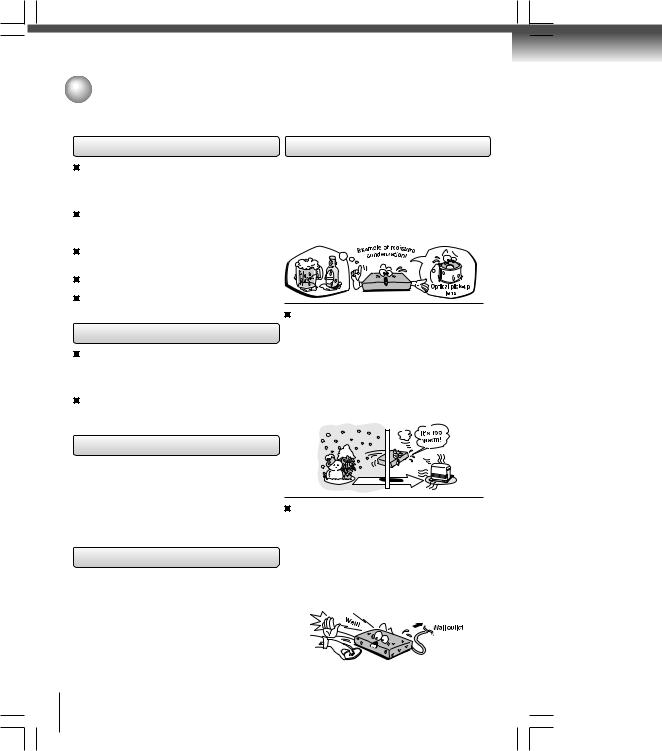
Introduction
 Precautions
Precautions
Notes on handling
When shipping the DVD player, the original shipping carton and packing materials come in handy. For maximum protection, repack the unit as it was originally packed at the factory. Take care not to give it a shock or shake when carrying.
Do not use volatile liquids, such as insect spray, near the DVD player. Do not leave rubber or plastic products in contact with the DVD player for a long time. They will leave marks on the finish.
The top and rear panels of the DVD player may become warm after a long period of use. This is not a malfunction.
When the DVD player is not in use, be sure to remove the disc and turn off the power.
If you do not use the DVD player for a long period, the unit may not function properly in the future. Turn on and use the DVD player occasionally.
Notes on locating
Place the DVD player on a level surface. Do not use it on a shaky or unstable surface such as a wobbling table or inclined stand. The loaded disc may come off the proper position and cause damage to the DVD player.
When you place this DVD player near a TV, radio, or VCR, the playback picture may become poor and the sound may be distorted. In this case, place the DVD player away from the TV, radio, or VCR.
Notes on cleaning
Use a soft, dry cloth for cleaning.
 For stubborn dirt, soak the cloth in a weak detergent solution, wring well and wipe. Use a dry cloth to wipe it dry.
For stubborn dirt, soak the cloth in a weak detergent solution, wring well and wipe. Use a dry cloth to wipe it dry.
Do not use any type of solvent, such as thinners and benzene, as they may damage the surface of the DVD player.
 If you use a chemical saturated cloth to clean the unit, follow that product’s instructions.
If you use a chemical saturated cloth to clean the unit, follow that product’s instructions.
Inspection and Maintenance
This DVD player is a high technology, precision device. If the optical pick-up lens and disc drive parts become dirty or worn down, the picture quality may be reduced. To avoid reduction in picture quality, it is recommended that regular inspection and maintenance (cleaning or parts replacement) be performed every 1,000 hours of use. For further details, contact your nearest consumer electronics dealer.
Notes on moisture condensation
Moisture condensation damages the DVD player. Please read the following carefully.
Moisture condensation occurs, for example, when you pour a cold drink into a glass on a warm day. Drops of water form on the outside of the glass. In the same way, moisture may condense on the optical pick-up lens inside this unit, one of the most crucial internal parts of the DVD player.
Moisture condensation occurs during the following cases.
 When you bring the DVD player directly from a cold place to a warm place.
When you bring the DVD player directly from a cold place to a warm place.
 When you use the DVD player in a room where you just turned on the heater, or a place where the cold wind from the air conditioner directly hits the unit.
When you use the DVD player in a room where you just turned on the heater, or a place where the cold wind from the air conditioner directly hits the unit.
 In summer, when you use the DVD player in a hot and humid place just after you move the unit from an air conditioned room.
In summer, when you use the DVD player in a hot and humid place just after you move the unit from an air conditioned room.
 When you use the DVD player in a humid place.
When you use the DVD player in a humid place.
Do not use the DVD player when moisture condensation may occur.
If you use the DVD player in such a situation, it may damage discs and internal parts. Remove the disc, connect the power cord of the DVD player to the wall outlet, turn on the DVD player, and leave it for two or three hours. After two or three hours, the DVD player will have warmed up and evaporated any moisture. Keep the DVD player connected to the wall outlet and moisture condensation will seldom occur.
4

 Notes on Discs
Notes on Discs
On handling discs
 Do not touch the playback side of the disc.
Do not touch the playback side of the disc.
 Playback side
Playback side
 Do not attach paper or tape to discs.
Do not attach paper or tape to discs.
On cleaning discs
Structure of disc contents
Normally, DVDs are divided into titles, and the titles are sub-divided into chapters.VIDEO CDs and audio CDs are divided into tracks.
DVD
|
|
|
|
|
|
|
|
|
|
|
|
DVD |
|
|
|
|
|
|
||||||
|
|
|
|
|
|
|
|
|
|
|
|
|
|
|
|
|
||||||||
|
|
|
|
|
|
|
|
|
|
|
|
|
|
|
|
|
|
|
|
|
|
|
|
|
|
|
|
Title 1 |
|
|
|
|
|
|
|
|
|
|
Title 2 |
|
|
|
|
|
|||||
|
Chapter |
|
|
|
Chapter 1 |
|
|
|
|
|
||||||||||||||
|
|
|
|
|
|
|
|
|||||||||||||||||
|
1 Chapter 2 |
Chapter 2 Chapter 3 |
|
|||||||||||||||||||||
|
|
|
|
|
|
|
|
|
|
|
|
|
|
|
|
|
|
|
|
|
|
|
|
|
|
|
|
|
|
|
|
|
|
|
|
|
|
|
|
|
|
|
|
|
|
|
|
|
|
|
|
|
|
|
|
|
|
|
|
|
|
|
|
|
|
|
|
|
|
|
|
|
|
|
|
|
|
|
|
|
|
|
|
|
|
|
|
|
|
|
|
|
|
|
|
|
|
|
|
|
|
|
|
|
|
|
|
|
|
|
|
|
|
|
|
|
|
|
|
|
|
|
|
|
VIDEO CD/audio CD
 VIDEO CD/audio CD
VIDEO CD/audio CD
Track 1 |
Track 2 |
Track 3 |
Track 4 |
Track 5 |
Introduction
 Fingerprints and dust on the disc cause picture and sound deterioration. Wipe the disc from the center outwards with a soft cloth. Always keep the disc clean.
Fingerprints and dust on the disc cause picture and sound deterioration. Wipe the disc from the center outwards with a soft cloth. Always keep the disc clean.
Each title, chapter or track is assigned a number, which is called “title number”, “chapter number” or “track number” respectively.
There may be discs that do not have these numbers.
 If you cannot wipe off the dust with a soft cloth, wipe the disc lightly with a slightly moistened soft cloth and finish with a dry cloth.
If you cannot wipe off the dust with a soft cloth, wipe the disc lightly with a slightly moistened soft cloth and finish with a dry cloth.
 Do not use any type of solvent such as thinner, benzine, commercially available cleaners or antistatic spray for vinyl LPs. It may damage the disc.
Do not use any type of solvent such as thinner, benzine, commercially available cleaners or antistatic spray for vinyl LPs. It may damage the disc.
On storing discs
 Do not store discs in a place subject to direct sunlight or near heat sources.
Do not store discs in a place subject to direct sunlight or near heat sources.
 Do not store discs in places subject to moisture and dust such as a bathroom or near a humidifier.
Do not store discs in places subject to moisture and dust such as a bathroom or near a humidifier.
 Store discs vertically in a case. Stacking or placing objects on discs outside of their case may cause warping.
Store discs vertically in a case. Stacking or placing objects on discs outside of their case may cause warping.
Notes on copyright
The unauthorized recording, use, distribution, or revision of copyrighted materials including, without limitation, television programs, videotapes, and DVDs, is prohibited under the Copyright Laws of the United States and other countries, and may subject you to civil and criminal liability.
This product incorporates copyright protection technology that is protected by method claims of certain U.S. patents and other intellectual property rights owned by Macrovision Corporation and other rights owners. Use of this copyright protection technology must be authorized by Macrovision Corporation, and is intended for home and other limited viewing uses only unless otherwise authorized by Macrovision Corporation. Reverse engineering or disassembly is prohibited.
5
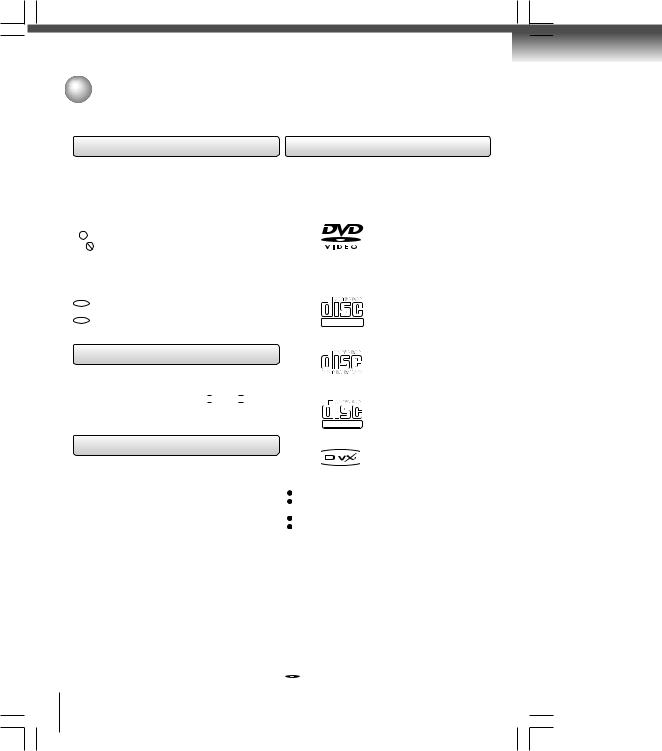
Introduction
 Notes on Discs (continued)
Notes on Discs (continued)
About this owner’s manual
This owner’s manual explains the basic instructions of this DVD player. Some DVDs are produced in a manner that allows specific or limited operation during playback. As such, the DVD player may not respond to all operating commands. This is not a defect in the DVD player. Refer to instruction notes of discs.
“ ” may appear on the TV screen during operation. A “ ” means that the operation is not permitted by the DVD player or the disc.
” may appear on the TV screen during operation. A “ ” means that the operation is not permitted by the DVD player or the disc.
About 



The


 icons on the heading bar show the playable discs for the function described under that heading.
icons on the heading bar show the playable discs for the function described under that heading.
DVD : You can use this function with DVD discs.  : You can use this function with Video CDs.
: You can use this function with Video CDs.
CD : You can use this function with Audio CDs/CD-R/RW CDs.
Notes on region numbers
The region number of this DVD player is 1. If region numbers, which stand for their playable area, are printed
on your DVD and you do not find  or
or  , disc
, disc
playback will not be allowed by the player. (In this case, the DVD player will display a message on-screen).
On VIDEO CDs
This DVD player supports VIDEO CDs equipped with the PBC (Version 2.0) function. (PBC is the abbreviation of Playback Control.) You can enjoy two playback variations depending on types of discs.
•VIDEO CD not equipped with PBC function (Version 1.1) Sound and movie can be played on this DVD player in the same way as an audio CD.
•VIDEO CD equipped with PBC function (Version 2.0) In addition to operation of a VIDEO CD not equipped with the PBC function, you can enjoy playback of interactive software with search function by using the menu displayed on the TV screen (Menu Playback). Some of the functions described in this owner’s manual may not work with some discs.
Playable discs
This DVD player can play the following discs.
|
Disc Mark |
Contents |
Disc |
|
Maximum |
|
|
|
Size |
|
playback time |
|
|||
|
|
|
|
|
|
||
|
|
|
|
|
|
|
|
|
|
|
|
|
|
Approx. 4 hours |
|
|
|
|
|
12 cm |
|
(single sided disc) |
|
|
|
|
Audio |
|
|
|
|
|
|
|
|
|
Approx. 8 hours |
|
|
|
|
|
+ |
|
|
|
|
DVDs |
|
|
|
|
(double sided disc) |
||
|
|
video |
|
|
|||
|
|
|
(moving |
|
|
Approx. 80 minutes |
|
|
|
|
pictures) |
8 cm |
|
(single sided disc) |
|
|
|
|
|
|
|
|
|
|
|
|
|
|
Approx. 160 minutes |
||
|
|
|
|
|
|
||
|
|
|
|
|
|
(double sided disc) |
|
|
|
|
|
|
|
|
|
|
|
|
Audio |
12 cm |
|
Approx. 74 minutes |
|
VIDEO |
|
|
+ |
|
|||
|
|
|
|
|
|
||
|
|
video |
|
|
|
|
|
CDs |
|
|
|
|
|
|
|
|
|
(moving |
|
|
|
|
|
|
|
|
8 cm |
|
Approx. 20 minutes |
||
|
DIGITAL VIDEO |
pictures) |
|
||||
|
|
|
|
|
|||
|
|
|
|
|
|
|
|
Audio |
|
|
|
12 cm |
|
Approx. 74 minutes |
|
|
|
Audio |
|
|
|
|
|
CDs |
|
|
8 cm |
|
Approx. 20 minutes |
||
|
|
|
|
||||
|
|
|
|
(CD |
|
||
|
|
|
|
single) |
|
|
|
|
|
|
|
|
|
|
|
SUPER |
|
|
Audio |
12 cm |
|
35 min. |
|
|
|
+ |
|
|
|||
|
|
|
|
|
|
||
VIDEO |
|
|
video |
|
|
|
|
CDs |
SUPER VIDEO |
(moving |
8 cm |
|
10 min. |
|
|
|
|
|
pictures) |
|
|
||
|
|
|
|
|
|
|
|
|
|
|
|
|
|
|
|
|
|
|
Audio |
12 cm |
|
|
|
|
|
|
+ |
|
It depends on DivX |
® |
|
DivX® |
|
|
|
|
|||
|
|
video |
|
|
|
||
|
|
|
|
quality |
|
||
|
|
|
(moving |
8 cm |
|
|
|
|
|
|
pictures) |
|
|
|
|
|
|
|
|
|
|
|
|
|
|
|
|
|
|
|
|
The following discs are also available. |
|
|
|||||
DVD±R/±RW and DVD-ROM discs of DVD format |
|
||||||
CD-R/CD-RW discs of CD-DA, Video CD, MP3, WMA or |
|
||||||
JPEG format |
|
|
|
|
|
||
Official DivX® Certified product |
|
|
|
|
|||
Plays all versions of DivX® video (including DivX® 6) with |
|
||||||
standard playback of DivX® media files |
|
|
|||||
Some of these discs may be incompatible. |
|
|
|||||
|
|
|
|
|
|
|
|
•You cannot play discs other than those listed above.
•You cannot play DVD-RAM discs or non-standardized discs, etc., even if they may be labeled as above.
•This DVD player uses the NTSC color system, and cannot play DVDs recorded in any other color system (PAL, SECAM, etc.).
Because of problems and errors that can occur during the creation of DVD and CD software and/or the manufacture of DVD and CD discs, Toshiba cannot assure that this DVD player will successfully play every disc bearing the DVD and CD logos. If you happen to experience any difficulty playing a DVD and/ or CD disc on this DVD player, please contactToshiba Customer Service.
 is a trademark of DVD Format/Logo Licensing Corporation.
is a trademark of DVD Format/Logo Licensing Corporation.
6
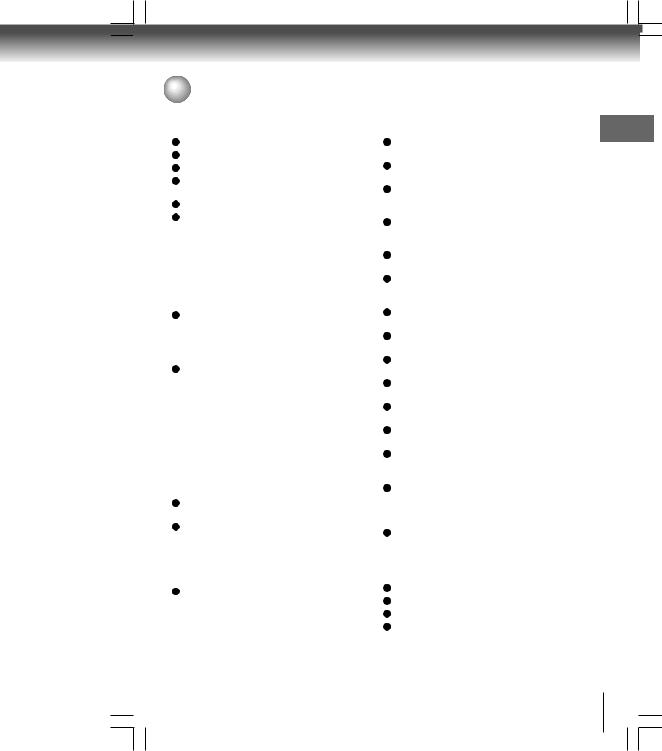
 Table of Contents
Table of Contents
Introduction |
|
SAFETY PRECAUTIONS ........................... |
2 |
IMPORTANT SAFETY INSTRUCTIONS .... |
3 |
Precautions ............................................... |
4 |
Notes on Discs .......................................... |
5 |
Notes on region numbers ................................... |
6 |
Table of Contents ...................................... |
7 |
Identification of Controls ......................... |
8 |
Front panel .......................................................... |
8 |
Rear panel .......................................................... |
8 |
DVD display ........................................................ |
8 |
Remote control .................................................... |
9 |
Loading batteries ............................................... |
10 |
Operating with the remote control ...................... |
10 |
Connections |
|
Connecting to a TV .................................. |
11 |
Connecting to a TV ............................................. |
11 |
Connecting to a TV (Using the component video |
|
jacks) ................................................................. |
11 |
Connecting to a display (Using a HDMITM cable) ......... |
12 |
Connecting to Optional Equipment ....... |
13 |
Connecting to an amplifier equipped with a |
|
Dolby® Digital decoder ......................................... |
14 |
Connecting to an amplifier equipped with |
|
Dolby Surround Pro Logic .............................. |
14 |
Connecting to an amplifier equipped with a |
|
DTS® decoder .................................................. |
15 |
Connecting to an amplifier equipped with an MPEG2 |
|
audio decoder .................................................. |
15 |
Connecting to an amplifier equipped with a |
|
digital audio input ........................................... |
15 |
Basic playback |
|
Playing a Disc .......................................... |
16 |
Basic playback ................................................ |
16 |
Variable Speed Playback ......................... |
17 |
Playing in fast reverse or fast forward |
|
directions ......................................................... |
17 |
Playing frame by frame .................................... |
17 |
Playing in slow-motion ...................................... |
17 |
Resuming playback from the same location ..... |
17 |
Locating a Desired Section .................... |
18 |
Locating a title using the top menu ..................... |
18 |
Locating a specific chapter or track .................. |
18 |
Advanced playback |
|
Accessing a Specific Location Directly ........... |
19 |
Locating a specific title/chapter/time ................... |
19 |
Repeating a Specific Segment ................. |
20 |
Repeating a specific segment ............................ |
20 |
Playing in a Varied Order ......................... |
20 |
Playing titles, chapters or tracks in a varied |
|
order .................................................................. |
20 |
Playing in a Favorite Order ...................... |
21 |
Setting titles, chapters or tracks in a favorite |
|
order .................................................................. |
21 |
Zooming a Picture ..................................... |
22 |
Zooming a picture ............................................. |
22 |
Selecting the Sound Enhancement |
|
(E.A.M.) ...................................................... |
22 |
Selecting the sound enhancement ................... |
22 |
Selecting the Picture Mode ...................... |
23 |
Selecting the picture mode ................................. |
23 |
Selecting Subtitles ................................... |
23 |
Selecting a subtitle language .............................. |
23 |
Selecting the Camera Angle .................... |
24 |
Changing the camera angle ................................ |
24 |
Selecting a Language ............................... |
24 |
Selecting a playback audio setting ..................... |
24 |
On-screen Display Operation .................. |
25 |
On-screen display operation .............................. |
25 |
Playing MP3/WMA Files ........................... |
26 |
Playing MP3/WMA files ...................................... |
26 |
Viewing JPEG Files .................................. |
27 |
Viewing JPEG files ............................................ |
27 |
Viewing a thumbnail view ................................... |
27 |
Playing DivX® /MPEG-4 Files .................... |
28 |
Playing DivX® /MPEG-4 files ............................... |
28 |
Function setup |
|
Customizing the Function Settings ........ |
29 |
Setting procedure ............................................... |
29 |
Setting details ..................................................... |
29 |
Others |
|
Table of Languages ................................... |
35 |
Before Calling Service Personnel ........... |
36 |
Specifications ........................................... |
37 |
Limited Warranty ...................................... |
38 |
Introduction
7
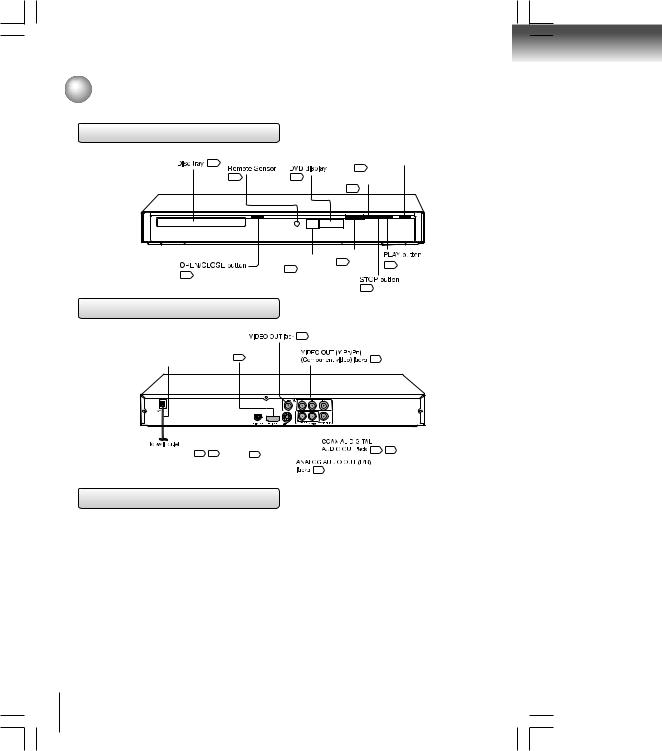
Introduction
 Identification of Controls
Identification of Controls
See the page in  for details.
for details.
Front panel
16 






 16
16
|
10 |
8 |
|
|
PAUSE button |
|
|
|
|
|
16 |
|
|
|
24F |
|
|
|
|
480p 1080p |
|
|
|
|
|
720p |
1080i |
|
|
|
|
HDMI indicator |
SKIP buttons |
||
|
|
18 |
16 |
||
|
|
12 |
|
||
|
|
|
|
||
16 |
|
|
|
|
|
|
|
|
|
|
|
|
|
|
|
|
16 |
Rear panel |
|
|
|
|
|
|
|
11 |
|
|
|
|
HDMI OUT |
|
|
|
|
Power Cord |
jack 12 |
|
|
|
11 |
|
|
|
|
|
|
|
|
|
|
|
|
|
|
|
|
|
|
|
|
|
|
|
|
|
|
|
|
|
|
|
|
|
|
|
|
|
|
|
|
|
|
|
|
|
|
|
|
|
|
|
|
|
|
|
|
|
|
|
|
|
|
|
|
|
|
|
|
|
|
|
|
|
|
|
|
|
|
|
|
|
|
|
|
|
|
OPTICAL OUT jack |
S-VIDEO OUT jack |
|
|
|
|
14 |
15 |
||||||||||||
|
|
|
|
||||||||||||||||
14 |
15 |
11 |
|
|
|
|
|
|
|
||||||||||
|
|
|
|
|
|
|
|
11 |
|
|
|
|
|
|
|
|
|
||
|
|
|
|
|
|
|
|
|
|
|
|
|
|
|
|
|
|||
|
|
|
|
|
|
|
|
|
|
|
|
|
|
|
|
|
|||
DVD display
The indicators vary depending on the kinds of discs you |
|
|
|
Chapter/Track number Indicator |
|
|||||||||||||||||
play. |
|
|
|
|
|
|
|
|
|
|
|
|
|
|
|
|
|
|
|
|
||
|
|
|
|
|
|
|
|
|
|
|
|
|
|
|
|
|
|
|
|
|
|
|
|
No disc |
|
|
Bad disc |
|
|
|
|
|
|
|
|
|
|
|
|
|
|
|
|
|
|
|
|
|
|
|
|
|
|
|
|
|
|
|
|
|
|
|
|
|
|
|
|
|
|
|
|
|
|
|
|
|
|
|
|
|
|
|
|
|
|
|
|
|
|
|
|
|
|
|
|
|
|
|
|
|
|
|
|
|
|
|
|
|
|
|
|
|
|
|
|
|
|
|
|
|
|
|
|
|
|
Multifunctional indicator (indicates |
|
||||||||||
|
|
|
|
|
|
|
|
|
|
|
operating status or messages, etc.) |
|
||||||||||
|
|
|
|
|
|
|
|
|
|
|
|
|
|
|
|
|
|
|
|
|
|
|
|
DVD VIDEO |
|
|
VIDEO CD |
|
|
Audio CD |
|
|
|
|
OPEN |
|
|
|
LOAD/CLOSE |
|
|||||
|
• During playback: |
|
• During playback: |
|
• During playback: |
|
|
|
|
|
|
|
|
|
|
|
|
|
|
|||
|
Example |
|
Example |
|
Example |
|
|
|
|
|
|
|
|
|
|
|
|
|
|
|||
|
|
|
|
|
|
|
|
|
|
|
|
|
|
|
|
|
|
|
|
|
|
|
|
|
|
|
|
|
|
|
|
|
|
|
|
|
|
|
|
|
|
|
|
|
|
Some discs may only |
Some discs may only |
|
Some discs may only |
|
|
|
|
|
|
|
|
|
|
|
|
|
|
|||||
display chapter numbers. |
display track numbers. |
|
display track numbers. |
|
|
|
|
|
|
|
|
|
|
|
|
|
|
|||||
|
|
|
|
|
|
|
|
|
|
|
|
|
|
|
|
|
|
|
|
|
|
|
8
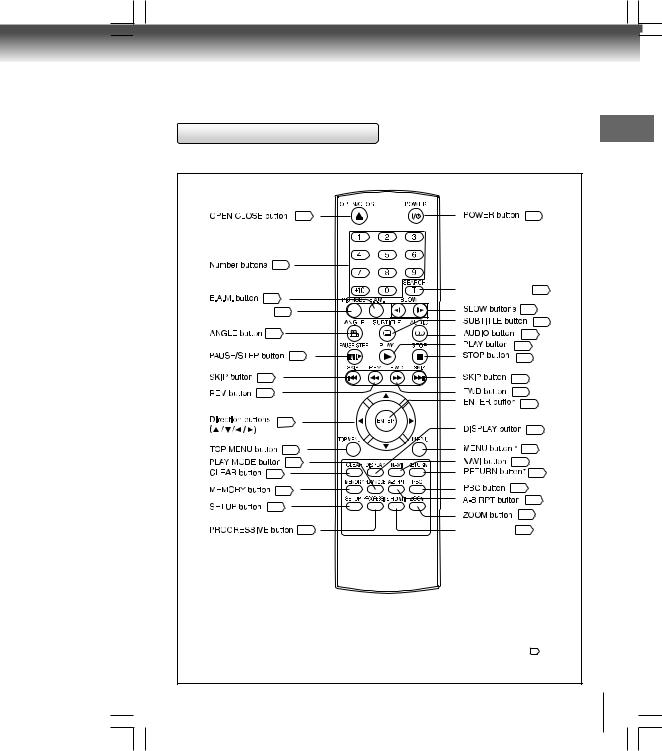
Remote control
The instructions in this manual describe the functions on the remote control. See the page in  for details.
for details.
16 |
16 |
19 |
|
22 |
T / SEARCH button 19 |
|
|
PIC MODE button 23 |
17 |
23
24 |
24 |
|
17 |
16 |
|
16 |
||
18 |
18 |
|
17 |
17 |
|
|
18 |
|
18 |
25 |
|
|
||
18 |
16 |
|
20 |
25 |
|
19 |
* 16 |
|
21 |
16 |
|
20 |
||
29 |
||
22 |
||
|
||
12 |
HDMI button 12 |
* RETURN button |
* MENU button |
Return to menu display for VCD (2.0) discs with |
Use the MENU button to display the menu included on |
menu. |
many DVDs.To operate a menu, follow the instructions |
|
in “Locating a title using the top menu.”18 |
Introduction
9
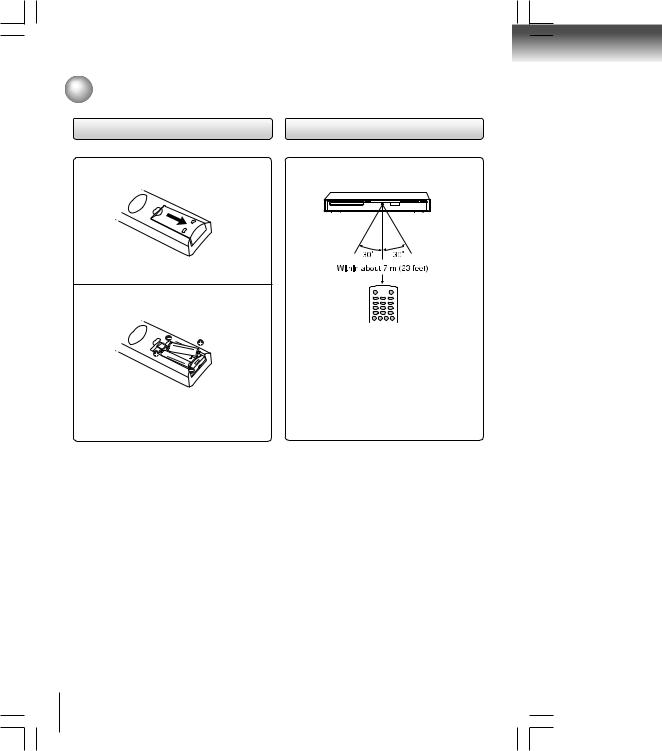
Introduction
 Identification of Controls (continued)
Identification of Controls (continued)
Loading batteries
1 Open the cover.
2 Insert batteries (R03/AAA size).
Operating with the remote control
Point the remote control at the remote sensor and press the buttons.
Make sure to match the + and – on the batteries to the marks inside the battery compartment.
Caution
• Never throw batteries into a fire.
Notes
•Be sure to use R03/AAA size batteries.
•Dispose of batteries in a designated disposal area.
•Attention should be drawn to the environmental aspects of battery disposal.
•Do not mix different battery types or combine used batteries with new ones.
•If the remote control does not operate correctly, or if the operating range becomes reduced, replace both batteries with new ones.
•If the batteries are dead or if you will not be using the remote control for a long time, remove the batteries to prevent battery acid from leaking into the battery compartment.
Distance: About 7 m (23 feet) from the front of the remote sensor
Angle: About 30° in each direction of the front of the remote sensor
*Do not expose the remote sensor of the DVD player to a strong light source such as direct sunlight or other illumination. If you do so, you may not be able to operate the DVD player via the remote control.
Notes on the remote control
•Direct the remote control at the remote sensor of the DVD player.
•When using the remote control, press the buttons at intervals of about 1 second to ensure the correct mode of operation.
•Do not drop or give the remote control a shock.
•Do not leave the remote control near an extremely hot or humid place.
•Do not spill water or put anything wet on the remote control.
•Do not open the remote control.
•If the remote control is not going to be used for a long time, remove the battery to avoid damage caused by battery leakage corrosion.
CAUTIONS:
•Danger of explosion if battery is incorrectly replaced. Replace only with the same or equivalent type.
•Batteries shall not be exposed to excessive heat such as sunshine, fire or the like.
•Do not dispose of battery in fire; battery may explode or leak.
•When discarding batteries, environmental problems must be considered and local rules or laws governing the disposal of these batteries must be strictly followed.
10
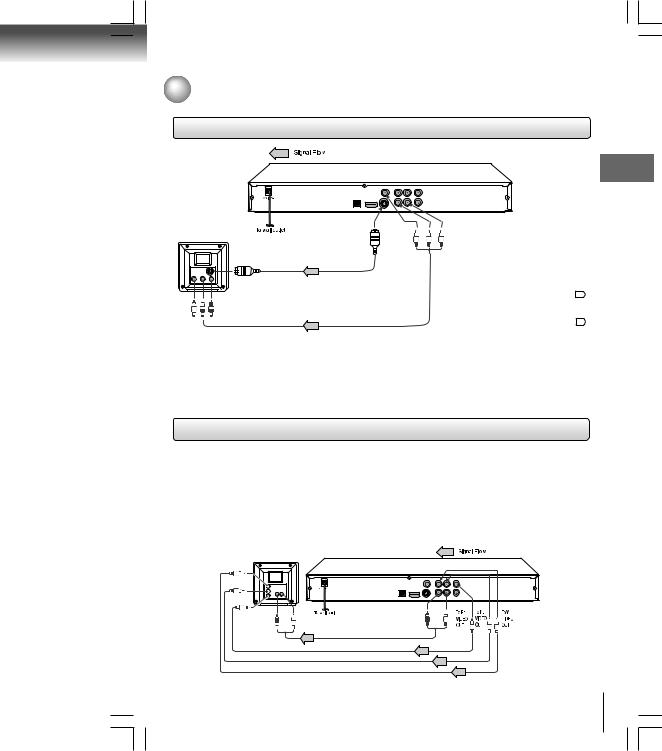
Connnections
 Connecting to a TV
Connecting to a TV
Connect the DVD player to your TV.
Connecting to aTV
Connections
Normal TV
 To video
To video

 input
input 

 (yellow)
(yellow)
Notes
To VIDEO OUT (yellow)
S-Video cable (not supplied)
If the TV has a S-video input, connect the DVD player with an S-video cable.When using an S-video cable, do not connect the yellow video cable and component video cables (Y/PB/PR).
Audio/Video cable (supplied)
To 2ch AUDIO OUT (R: red, L: white)
• Make the following setting.
On-screen display |
Select: |
Page |
|
|
|
|
|
“Digital Output” |
“Off”, |
32 |
|
“PCM” or |
|||
|
|
||
|
“Bitstream” |
|
|
|
|
|
|
“Video Output” |
Component |
|
|
S-VIDEO |
31 |
||
|
|||
|
P-Scan |
|
|
|
HDMI |
|
•Refer to the owner’s manual of the connected TV as well.
•When you connect the DVD player to your TV, be sure to turn off the power and unplug both units from the wall outlet before making any connections.
•If your television set has one audio input, connect the left and right audio outputs of the DVD player to aY cable adapter (not supplied) and then connect to your TV.
•Connect the DVD player directly to your TV. If you connect the DVD player to a VCR, TV/VCR combination or video selector, the playback picture may be distorted as DVDs are copy protected.
•Analog audio out will not have sound if DTS playback is selected.
Connecting to aTV (Using the component video jacks)
Interlaced outputs (ColorStream® )
Some TVs or monitors are equipped with component video inputs. Connecting to these inputs allows you to enjoy higher quality picture playback.
Actual labels for component video inputs may vary depending on the TV manufacturer. (ex.Y, R-Y, B-Y orY, CB, CR)
In some TVs or monitors, the color levels of the playback picture may be reduced slightly or the tint may change. In such a case, adjust the TV or monitor for optimum performance.
Progressive outputs (ColorStream Pro® )
Some TVs or monitors are equipped with component video inputs that are capable of reproducing a progressively scanned video signal. Connecting to these inputs allows you to view the highest quality pictures with less flicker.
Consumers should note that not all high definition television sets are fully compatible with this product and may cause artifacts to be displayed in the picture. In case of 480 progressive scan picture problems, it is recommended that the user switch the connection to the “standard definition” output. If there are questions regarding our TV set compatibility with this model 480p DVD player, please contact our Customer Service Center.
To Y video input
To PB video input
To PR video |
input |
To audio input 
To 2ch AUDIO OUT  (R: red, L: white)
(R: red, L: white) 
Audio cable (not supplied)
Component video cables (not supplied)
11
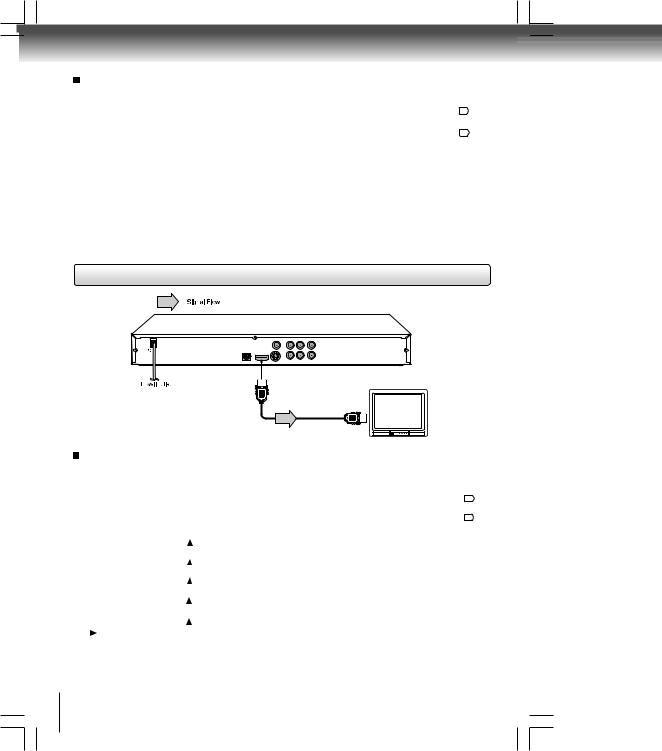
Connections
Switching the output signal (interlaced / progressive) using the remote control
You can temporarily switch the output signal for better picture quality. Press PROGRESSIVE button repeatedly on the remote control to select Video Output to P-Scan mode during stop.
If your TV does not support the progressive scan format, the picture will appear scrambled or blank. To return to normal picture, press PROGRESSIVE button repeatedly to turn off progressive mode.
Notes
• Make the following setting.
On-screen display |
Select: |
Page |
|
|
|
|
|
“Digital Output” |
“PCM” or |
32 |
|
“Bitstream” |
|||
|
|
||
“Video Output” |
Component |
|
|
*P-Scan |
31 |
||
|
|||
|
(Progressive) |
|
|
|
|
|
*Only for TV equipped with component video input jacks which support the progressive scan.
•Refer to the owner’s manual of the connected equipment as well.
•When you connect the DVD player to other equipment, be sure to turn off the power and unplug all of the equipment from the wall outlet before making any connections.
•If you place the DVD player near a tuner or radio, the radio broadcast sound might be distorted. In this case, place the DVD player away from the tuner and radio.
•The output sound of the DVD player has a wide dynamic range. Be sure to adjust the receiver’s volume to a moderate listening level. Otherwise, high volume sound may damage your hearing as well as the speakers.
•Turn off the amplifier before you connect or disconnect the DVD player’s power cord. If you leave the amplifier power on, the speakers may be damaged.
•Analog audio out will not have sound if DTS playback is selected.
•ColorStream® and ColorStream Pro® are registered trademarks of Toshiba America Cousumer Products L.L.C.
Connecting to a display (Using a HDMITM cable)
To HDMI
Output
Available output signals are below:
• Auto
•480p (progressive)
•720p (progressive)
•1080i (interlaced)
•1080p (progressive)
•1080p/24F (progressive)
Switching the video quality (HDMI mode) using HDMI button on the remote control.
Press HDMI button on the remote control to receive a suitable video quality in STOP mode.The video quality is required to match your TV having HDMI feature and suitable quality. Please also check your TV owner’s manual. Press this button to change the output signals as below. See the HDMI indicator and select the appropriate output signal.
|
HDMI indicator |
Video output signal |
|
illuminates “ 1080p, 24F” |
1080p/24F (progressive) |
|
Press |
|
|
illuminates “ 1080p” |
1080p (progressive) |
|
Press |
|
|
illuminates“1080i” |
1080i (interlaced) |
|
Press |
|
|
|
|
|
illuminates“720p” |
720p (progressive) |
|
Press |
|
|
illuminates“480p” |
480p (progressive) |
|
Press |
|
|
illuminates “480p, 720p, |
Auto |
|
1080i,1080p” |
|
|
|
Press
480p, 720p, 1080i,1080p and 1080p/24F are signals created with this DVD Player from original 480i signal. The resolution of the picture may not be increased even if they are selected.
HDMI Cable
(not supplied)
HDMI-compatible display
• Make the following setting.
On-screen display |
Select: |
Page |
|
|
|
“Digital Output” |
“PCM” |
32 |
|
|
|
“Video Output” |
HDMI |
31 |
|
|
|
About HDMI
HDMI (High Definition Multimedia Interface) supports both video and audio on a single digital connection for use with DVD players, DTV, set-top boxes, and other AV devices. HDMI was developed to provide the technologies of High Bandwidth Digital Content Protection (HDCP) as well as Digital Visual Interface (DVI) in one specification. HDCP is used to protect digital content transmitted and received by DVI-compliant or HDMI-compliant displays.
HDMI has the capability to support standard, enhanced, or highdefinition video plus standard to multi-channel surround-sound audio. HDMI features included uncompressed digital video, a bandwidth of up to 2.2 gigabytes per second (with HDTV) signals, one connector (instead of several cables and connectors), and communication between the AV source and AV devices such as DTVs.
HDMI, the HDMI logo and High-Definition Multimedia Interface are trademarks or registered trademarks of HDMI licensing LLC.
12
